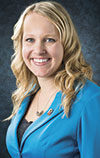To get there, manager John Schroeder and his team pays attention to all the details. He shared their strategy at the 2016 Cattlemen’s College, part of the Cattle Industry Convention and Trade Show in San Diego, California. The Darr team delays implants and follows a comprehensive health program, managing everything from pen condition to the mill.
“We have standard operating procedures for perfect mixing and delivery. Every biteful needs to be the same,” Schroeder said, noting they complement that with “perfect delivery.” That’s backed by monthly feed samples and regular feed-truck monitoring and maintenance, and even checks and balances with employees.
They want to maximize genetics and get into the premium choice category, and that means making the most of every day.
“Marbling is a linear line. Every day, you get an opportunity to put a marbling point in,” Schroeder said. He doesn’t know of a way to make up for missed opportunities to lay down that intramuscular fat.
That takes teamwork between feeder and ranch supplier, he said. Preconditioning done right – without cutting corners on duration or method – is important.
“Immunity. We want to build it at the ranch and at the yard, with timely vaccination, backed up with mineral and nutrition,” Schroeder said.
They “spike” vitamins at certain points in the feeding period and tailor mineral programs based on the class of cattle.
That all goes back to some of Schroeder’s key management philosophies: “Try to manage individuals and try to understand why they advance differently,” and “Match genetics and timely management to achieve your goals.”
Fellow presenter Jerry Wulf of Wulf Cattle, near Morris, Minnesota, explained his family’s “value-added” roots run deep. Their Limousin and Angus seedstock business got its start as a way to complement their feeding enterprise.
They needed an influx of consistent genetics. Yet, he looks to the end of the cycle before turning to the beginning.
“We wouldn’t want to attempt to raise those value-added cattle without knowing we had a market for them,” Wulf said. They currently produce for the non-hormone treated cattle (NHTC) and natural markets.
Still, those cattle bound for niche programs share the same difference-makers as conventional ones: “health, feed conversion and carcass.”
The Wulfs focus on cattle comfort.
“Happy cows are working for us and make our job a lot easier,” he said.
Echoing Schroeder’s comments about communication through the chain, he said if they can’t get individual carcass data back, they switch processors.
“Feeding only known genetics and having the relationship with cattlemen, and now dairymen, we feel we’re well-suited to go after what’s out there for value-added programs,” he said.
No matter what premiums a cattleman is going after, Schroeder added, this advice rings true: “You have to begin with the end in mind, and you have to have a plan.” ![]()
—From Certified Angus Beef LLC news release
PHOTO: Photo provided by Certified Angus Beef LLC.







